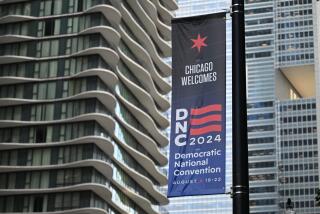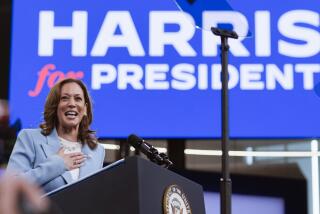Five things to know about the Illinois presidential primary
- Share via
Reporting from Chicago — On a balmy first day of spring, Illinois voters may play a decisive role in a Republican presidential marathon that started in the winter chill in neighboring Iowa.
Here are five things to know about this major Midwestern primary:
1. Voting early and often. It’s a tired political cliché, replete with tales of shady machine tactics and voters rising from the grave. But multiple voting is not only legal today, it’s essential. The primary ballot has two separate sections related to the presidential race. The first lists the candidates by name. That preference will produce headline numbers but it’s strictly a beauty contest. The important action is the voting for convention delegates, whose names are also on the ballot, pledged, in most cases, to a particular candidate. In the jargon of the trade, Illinois is a direct-election state (rules guru Josh Putnam explains at FrontloadingHQ). It means that voters are electing specific delegates — mostly well-known local officials — to represent them at the GOP nominating convention this summer.
2. Delegate math. In the weeks leading up to the early January filing deadline in Illinois, Rick Santorum was, as he likes to say, riding around Iowa in a pickup with a guy named Chuck. His longshot campaign barely had money for a motel room for the chief travelling aides — Santorum’s oldest kids. The campaign failed to get enough signatures to land delegates on the ballot in four of this state’s 18 congressional districts and, as a result, Santorum has already conceded to Romney at least 10 of the 54 delegates at stake in the primary. So, regardless of whether Santorum wins the popular vote (which seems unlikely, if pre-election polling was accurate) he is likely to lose the delegate battle to Romney, perhaps badly.
3. Lay of the Land of Lincoln. This state is remarkably simple, from the standpoint of election geography. There is Cook County, which includes Chicago — and after L.A. County is the most populous in the country — surrounded by a number of “collar counties.” Chicagoland, as the surronding area is known, makes up most of the statewide primary vote and about two-thirds of the state’s congressional districts. Behaviorally, it is moderate Republican territory, though suburban conservatives of the evangelical and social variety are a growing force that should help Santorum. The rest of Illinois is “downstate,” a vast, more conservative region that stretches to the outskirts of St. Louis and points south. Romney’s vote will be concentrated in the Chicago area, but he spent portions of the last three days courting voters downstate in an effort to cut into Santorum’s margins there.
4. Climate change. It doesn’t take a genius to predict that voter turnout will determine the outcome of today’s primary. Every election is, ultimately, decided by turnout (think about it). For the past week, Illinois has been basking in summerlike weather, as much as 25 degrees above average. Tuesday was no exception, with nothing in the air to hinder the casual voter. Chicago was expecting a record high of 85 degrees, and there was no rain in sight. That was a good omen for Romney, whose voters are likely to be less motivated than Santorum’s. There were a number of contested legislative primaries on the ballot that could influence turnout around the state, including areas where Santorum should do well. If predictions of lackluster turnout prove to be accurate, however, that could limit Romney’s ability to score a big win.
5. Body language. Nothing says momentum quite like a victorious presidential primary candidate soaking up adoring cheers from local supporters on election night. Newt Gingrich and Ron Paul, who campaigned briefly last week in Illinois, are long gone. Tuesday evening, Romney will be at a Marriott property in the Cook County suburb of Schaumburg. Santorum? He’s, ahem, in Pennsylvania -- which won’t vote for five weeks. That suggests that he figures he’ll lose Illinois and is already girding for what will be, for him, the must-win campaign of the year, in his home state. Santorum’s choice of venue Tuesday night -- Gettysburg, which does have a Lincoln tie-in -- is a curious one, to say the least. Expect some “high-water mark” references to his candidacy, particularly if Illinois proves to be a turning point in the campaign. Santorum could still upend the GOP race if he manages an upset, as he told supporters in Illinois last weekend. If Romney wins decisively, though, it’s the beginning of the end.
Follow PoliticsNow on Facebook
Five things to know about the Illinois presidential primary
More to Read
Sign up for Essential California
The most important California stories and recommendations in your inbox every morning.
You may occasionally receive promotional content from the Los Angeles Times.













